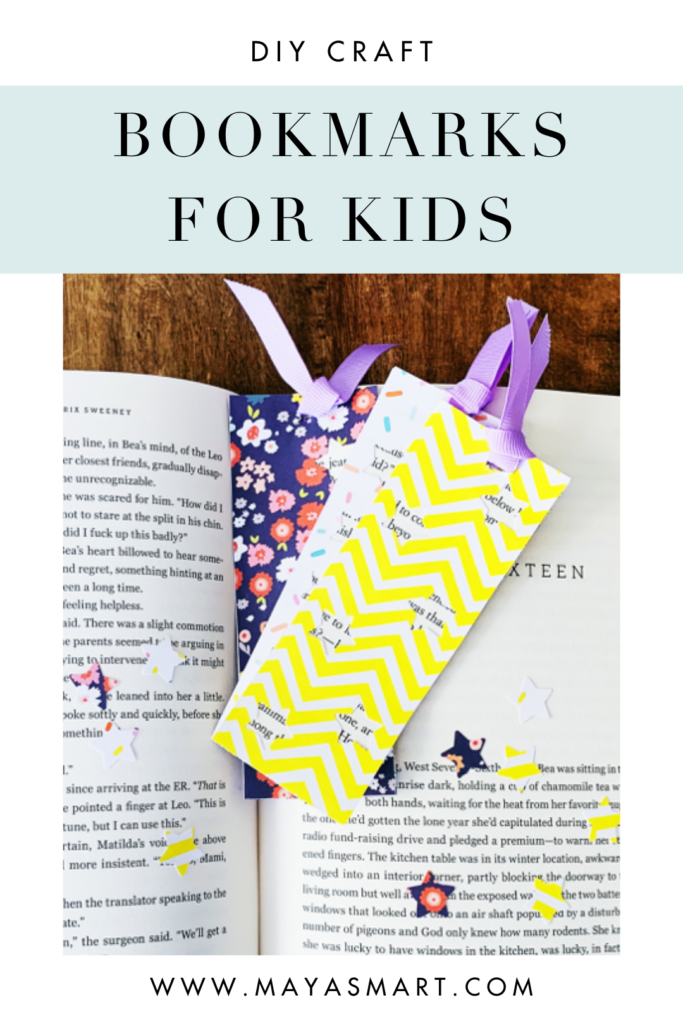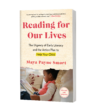By Maya Payne Smart
In reading, as in conversation, it’s not just what we say, but how we say it that matters.
The rhythm, pitch, and intonation someone brings to spoken words can convey meaning far beyond basic definitions. A shaky utterance might indicate fear or uncertainty. Changes in the pitch or speed of speech might accompany a compliment, signal anger, or communicate disappointment. Facial expressions and gestures, too, bring layers of interpretation and significance to text.
Reading fluency is the ability to read a text smoothly with rhythm, expression, and appropriate emotion, and it is a critical literacy skill. Its presence is a telltale sign that a child grasps the meaning of the words they’re reading and can convey their larger sense to others.
But this kind of rhythmic, expressive reading doesn’t just spring naturally from kids’ lips. It’s something that they learn by observation, through conversation, and from instruction.
Hearing parents and others reading aloud models it for kids. But caregivers should go a step further and engage in conversation with kids about how we can use our voices to communicate, by adjusting our tone, pace, and volume accordingly. Such discussion can awaken kids to their vocal power.
Beyond talking about expression, you can teach fluency and provide opportunities to practice it through a range of songs, games, and activities, including wordless picture book “readings.”
Check out a post by Jessica “Culture Queen” Hebron about how to use wordless picture books to teach reading fluency concepts.
We’ve all had them: those weakly bound paperback books that fall apart after a few readings. Upcycle the pages from those unsalvageable reads into these cute origami butterflies. You can string them along a garland, sprinkle them over a table or shelf-top, or perch them in a houseplant or festive tree. What a fun way to celebrate nature and reading!
This DIY book-page craft is easy once you get the hang of the folding, and a fun project to do with kids. I’ve broken down the folding into easy-to-follow steps below, with pictures of each step. So, go ahead, get your pages and get crafting!

Materials:
- Pages from obsolete books
- Scissors
- Ruler
- Pencil
- Colored pencils or markers
Cost: This craft should not cost you anything! You can always add to your butterfly collection, so save outdated books or falling-apart paperbacks, and reuse the pages for this sweet little craft.
Step One:
Trace squares from your book pages (each square will make one butterfly). I decided to make my squares 4” x 4” inches, because that was the width of the text on my page, but you can really do whatever size you would like. Just keep in mind, the smaller the square, the trickier the folds can be. For younger kids, make the squares as large as possible.
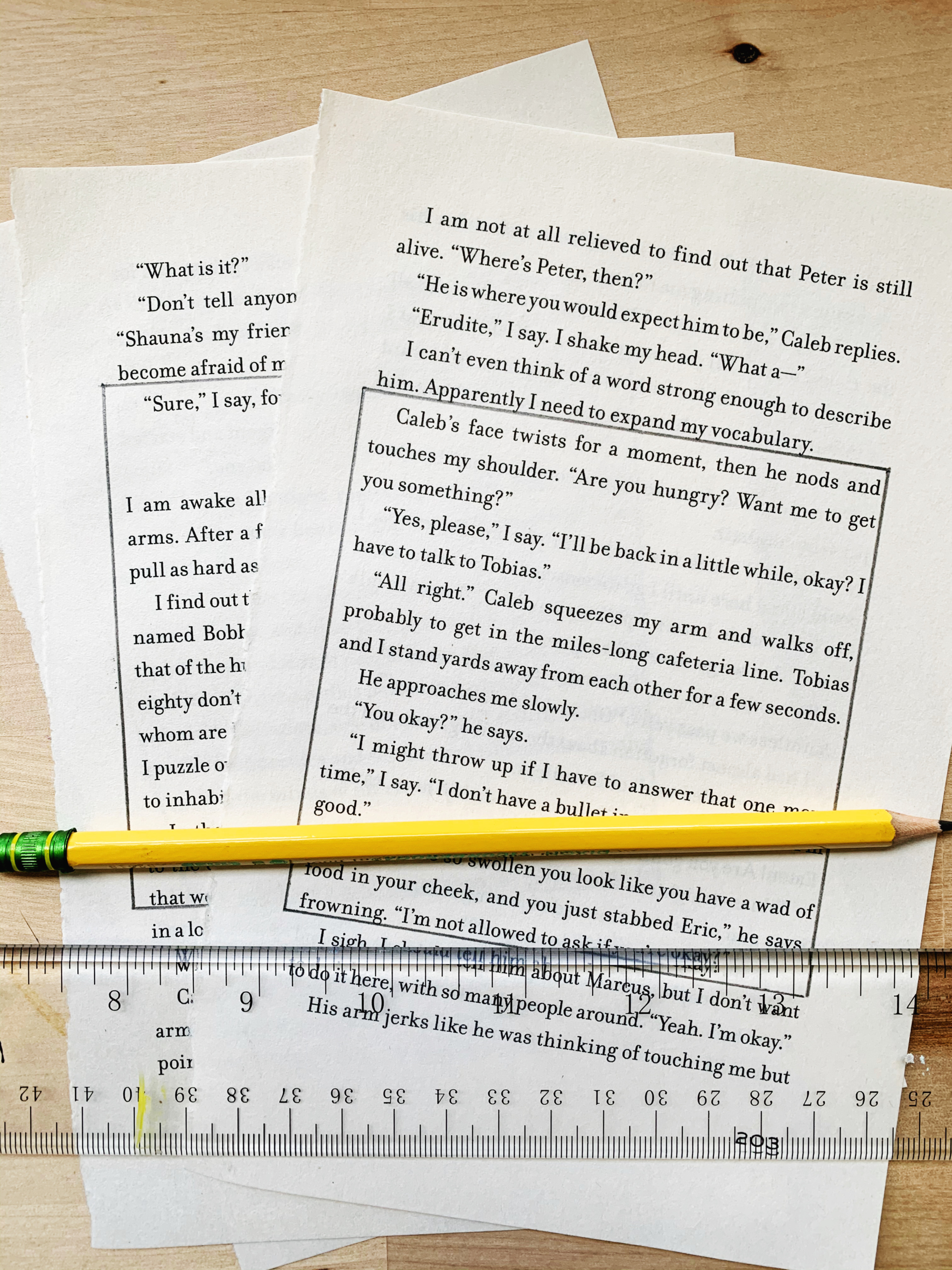
Step Two:
Once you have your squares traced on the book pages, go ahead and cut them out.
Optional: You can opt to color the pages at this point with your colored pencils, if you’re ok with a random pattern once they’re folded. (See Step four below.) Coloring before folding is a great adaptation for kids.
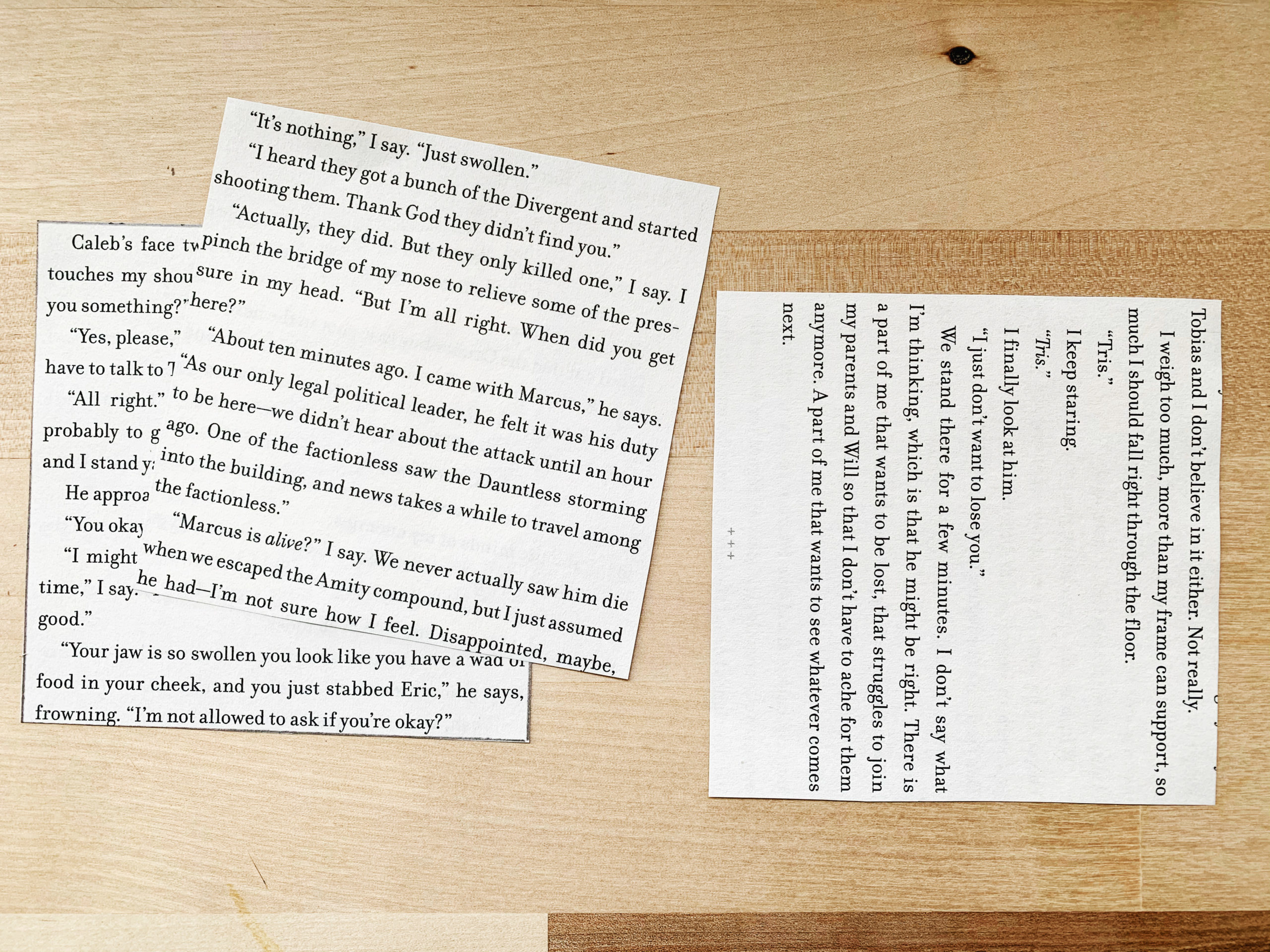
Step Three:
Now comes the folding! I am going to break this down, step by step, so just follow along! Be sure to crease each fold very well.
1. Fold your paper in half and crease it.

2. Now unfold it and then fold it in half the other way, creasing again.

3. Unfold, then fold it diagonally and crease.

4. Unfold, then fold and crease diagonally the other way. At the end of this step, you will have 8 little triangles from the creases of your folds.
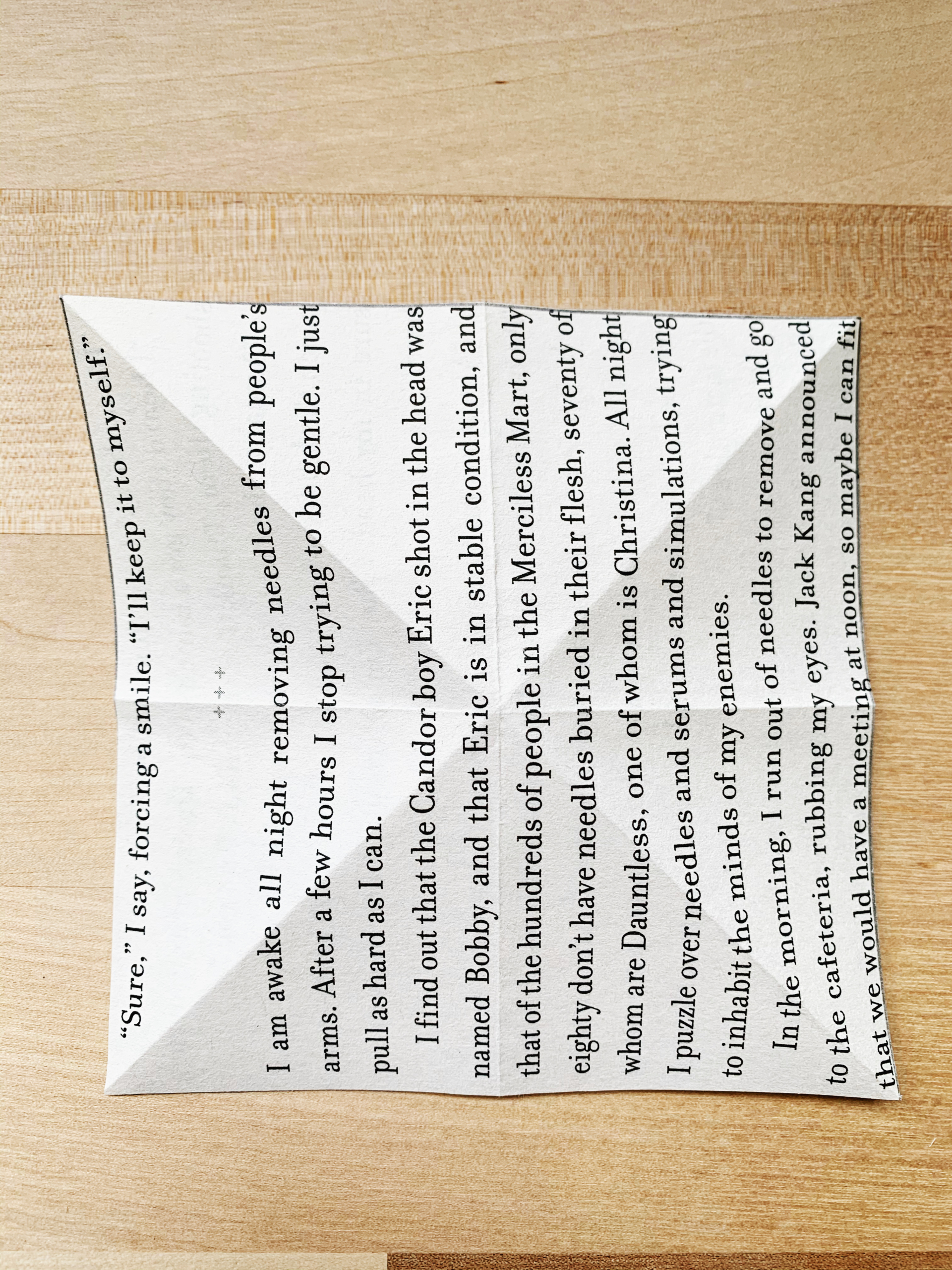
5. Next you will fold the center folds inwards to make a triangle. I think that this was the hardest fold, but the more you crease the previous folds, the easier this step is. You basically want to pinch and push two opposing triangles towards each other. It takes a minute, but you can do it!



6. Laying your triangle flat, fold the corner of the top layer up to the point of the triangle.

7. And now fold the other corner to also meet at the point

8. Now flip it over. You’ll be doing almost the same thing on this side, but this time fold the corner up to a point above the base, and crease just the center of the fold, leaving the edges uncreased.

9. Flip and fold the little triangle point over the top.

10. Lastly, pinch at the center, so the two top wings meet each other and crease the bottom so your butterfly can keep its form!


Step Four: If you didn’t color your butterfly before folding, this is the time to give your origami butterfly some life! Using colored pencils, color in the butterflies’ wings. You can look at some inspiration from your favorite butterflies, or just make up your own!
Note: If you want to keep the natural beauty of your book pages, you can also skip this step and decide not to add color to your butterfly. The simple text can be just as pretty!

Now all that is left to do is find a home for your fluttering friend and enjoy! How will you display your butterflies?

This cute twist on the classic apple-for-the-teacher theme creates a decorative apple from upcycled book pages. Help kids make them as teacher appreciation gifts, or to decorate their home “classroom.” You could even scale down the size and turn them into ornaments that can hang along a garland or off a tree.
This DIY book craft is inexpensive and fun! Ideally, you’ll use an exacto knife and hot glue gun, so be aware that you’ll need to do those steps for younger children. (You can adapt to use just scissors, but it will be more time-consuming.) The youngest children can help with this project by coloring the leaf, gathering a twig for the stem, helping paint the edges of the apple, and fanning out the pages.
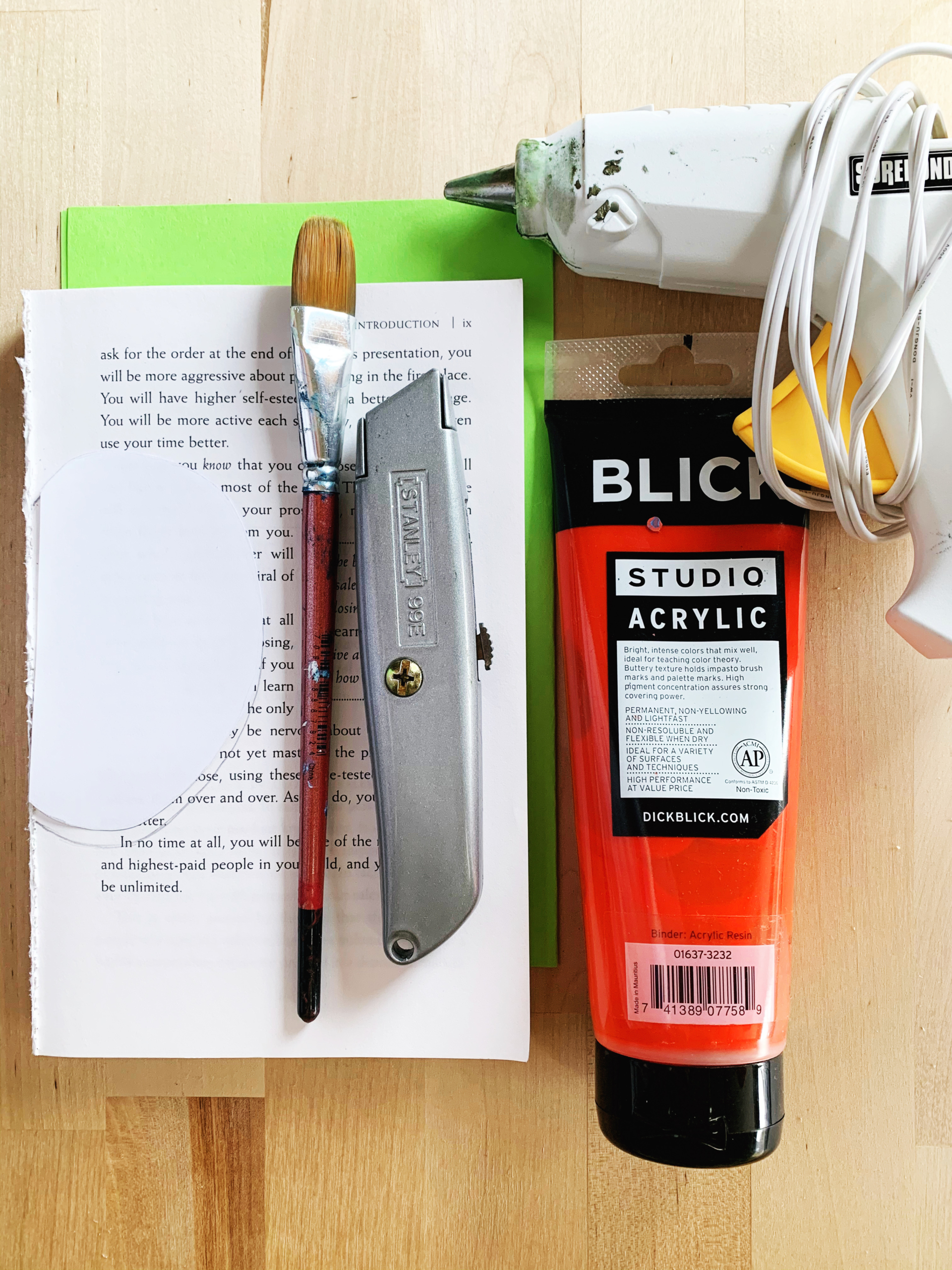
Materials:
- Paperback book with a sturdy spine (no falling-apart paperbacks)
- Glue gun & glue sticks
- Exacto knife
- Scissors
- Red paint & paint brush
- Green cardstock paper, or stiff paper colored green
- Twig
- A template of half an apple (see step one)
- Pencil for tracing
Cost: If you already have a glue gun, this craft should not cost you anything! Upcycle an obsolete paperback book, and send kids on a little scavenger hunt to find the perfect twig. If you don’t have green cardstock for the leaf, just color or paint a scrap of stiff paper green instead.
Step One:
First, you’ll need to create your template of half an apple. The best way is to print or draw a template of a whole apple of the size you want and then fold it in half. (This template is a good one.) You want to be sure there’s a straight, perpendicular line marking the half (which will form the core of your apple). Then cut out your template for tracing. If you like, you can paste your paper half-apple onto cardboard or cardstock to make the tracing easier, and then cut that out.

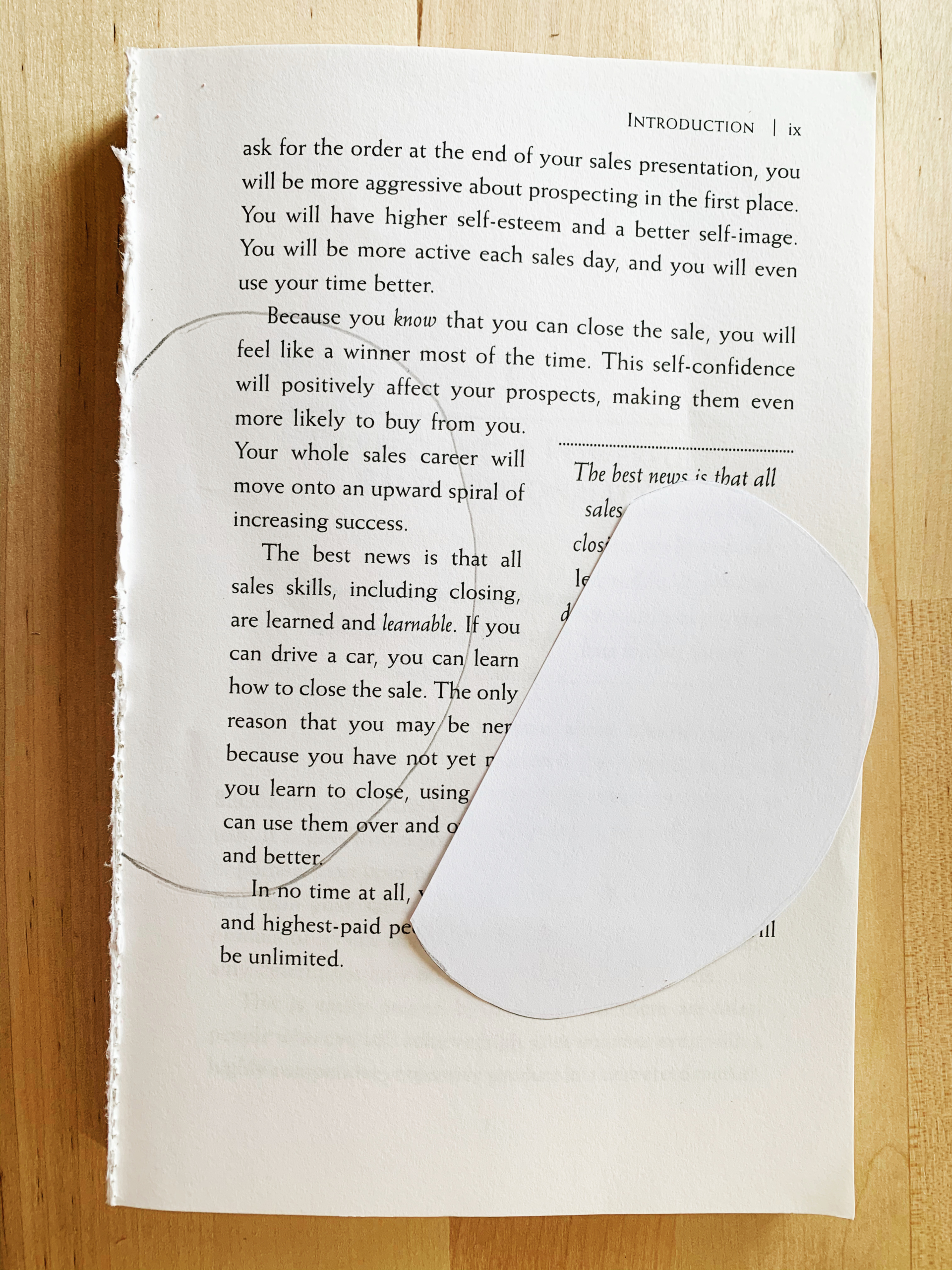
Step Two:
Remove the book’s cover, then align the flat edge of your template with the spine of the book and trace it onto the first page.
Step Three:
Use an exacto knife to cut out the half-apple shape that you just drew on the page. You will want to apply a little bit of pressure here, so as to cut through several pages of the book at once. Then simply remove the excess and cut around the shape to cut more pages. Repeat this process until you get through the entire book.
This step was a little trickier than I expected it to be, but just be patient. If you make a little mistake it’s totally fine! When all the pages fan out in the end you won’t be able to tell, so just keep going!
Note: If you don’t have an exacto knife, you can use scissors to cut a few pages of the book at a time. In this case, you’ll need to keep tracing the template onto the next set of pages.



Step Four:
Once you’ve cut all the pages, use scissors to cut away the excess of the spine.
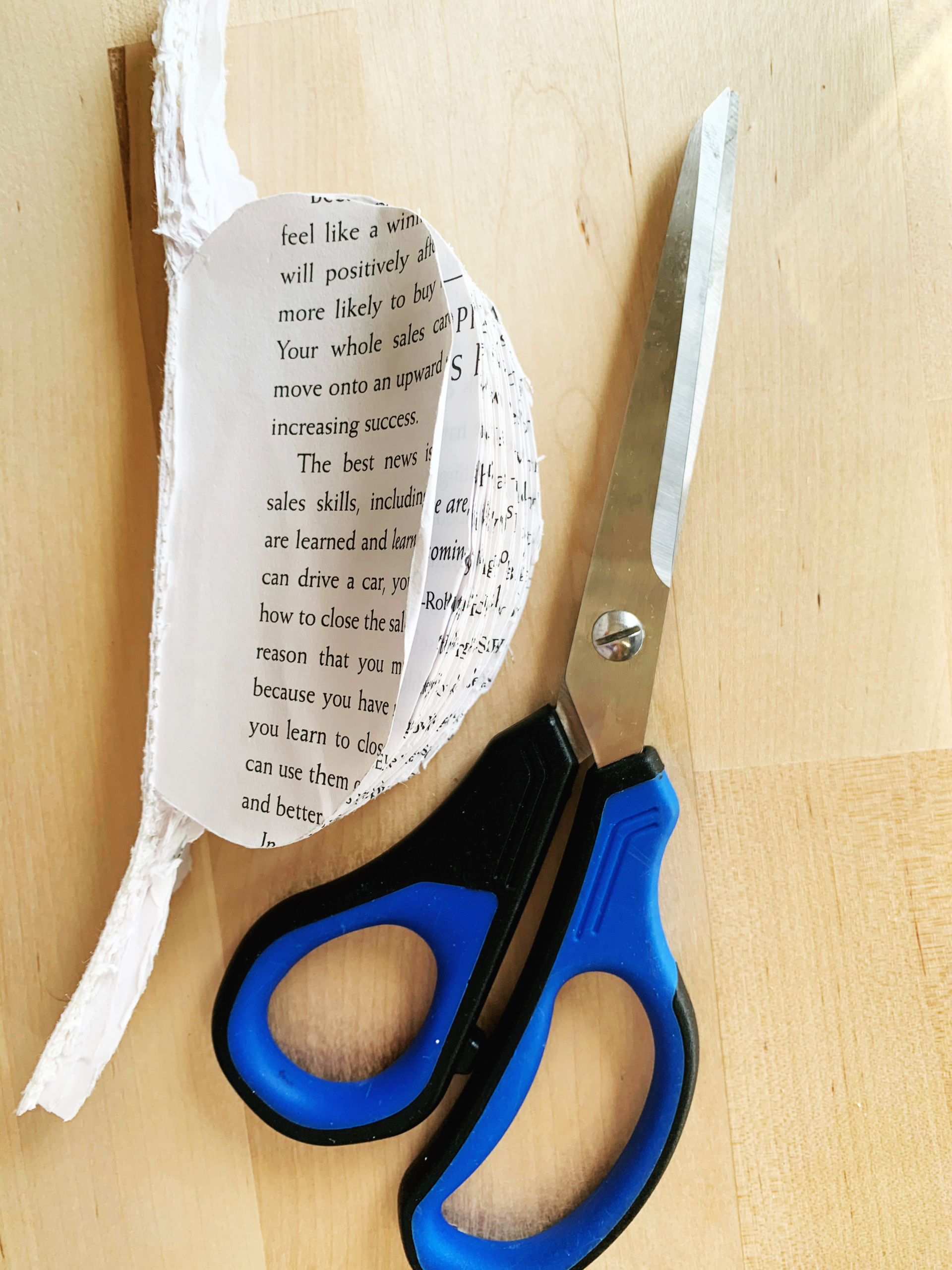

Step Five:
Next up is painting the very edges of the book pages red. I used acrylic paint, because it dries quickly and is easy to apply. Hold the pages together tightly, or lay them under another book or flat weight, to keep the pages together as you paint.
Tip: Paint lightly with the minimum of paint necessary, to keep the pages from being difficult to separate and fan out later. If working with kids, warn them that a little goes a long way here!
Note: An alternative idea could be to use a red marker instead to color the edge. This could be a bit easier to manage and lets you skip the next step, which is on the messier side!

Step Six:
When the paint is almost dry, start fanning out the pages so they won’t stick together. Then wait a little longer till the paint is dry to the touch. Once it’s dry, bend the spine of the book to make it pliable. I just kept bending different sections of pages back and forth till the pages started fanning out on their own.

Step Seven:
Now, using the glue gun, add some hot glue to the top of the spine and place your twig there, so the top is sticking up about an inch above the top of the pages. Wait a minute till the glue is dry and the twig is securely in place.

Step Eight:
Bend the spine again (being careful of the stick!) and add more hot glue to the rest of the spine as well as the first and last pages. Once your glue is in place, carefully bring those pages together and press along the spine to make your round apple (watching out for any glue that may soak through the page). Wait just a little for the glue to harden, then fan the pages out until your apple is nice and full.
Step Nine:
Cut out a little leaf from your green paper for the finishing touch, then attach it to the base of your twig with just a dot of glue.

Ta-da! You have your book page apple!
Will you gift or display yours? Let us know if you come up with any creative uses or twists on this project.

Kelsey Nickerson creates abstract paintings with rich color, texture, and movement, and enjoys a good book craft. She oversees web production and photography for MayaSmart.com.
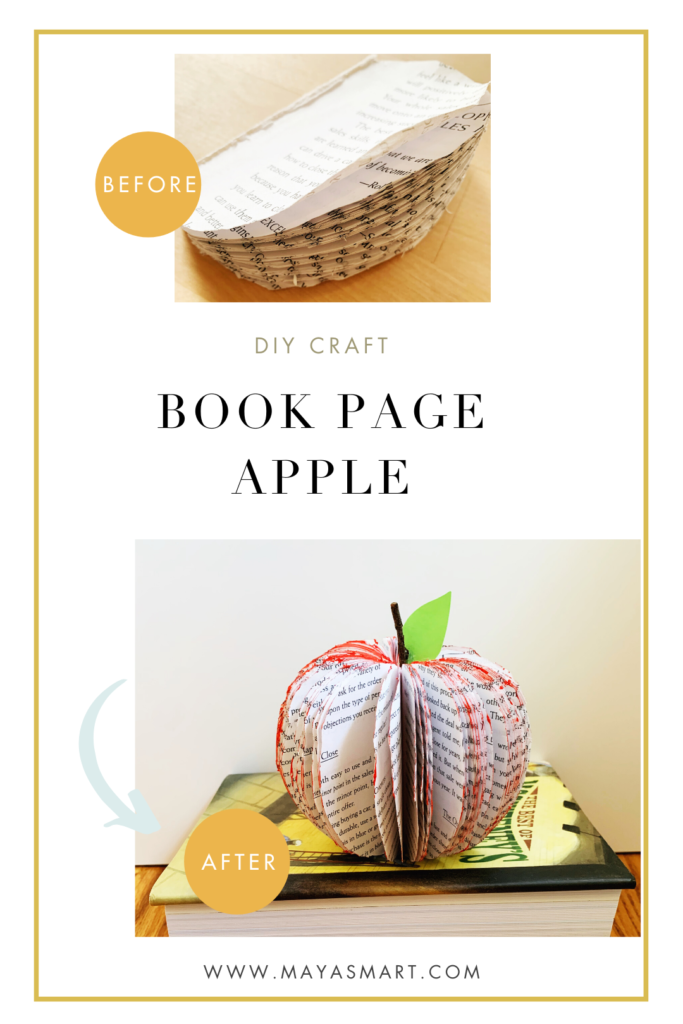
Wordless picture books are excellent tools for practicing reading fluency. This crucial literacy skill is defined as the ability to read a text smoothly with rhythm, expression, and appropriate emotion—and it’s a key indicator of reading comprehension.
I first came across this novel use of wordless picture books in The Megabook of Fluency by Tim V. Rasinski and Melissa Cheesman Smith, and it struck me as a great example of building crucial reading skills without directly reading.
As such, it’s perfect for bolstering kids’ literacy foundation in those crucial years before they begin formal reading instruction, as well as a fun way to increase fluency among early or struggling readers.
With no words on the books’ pages, the labor of “decoding,” or sounding out words, is taken off the table. Instead, kids can focus on storytelling style and creating meaning—the heart of fluency. They can practice using their voices to embody an emotion or illustrate a point, and learn how to interpret and convey meaning out of details on the page.
To demonstrate how to use wordless picture books effectively, I invited Jessica “Culture Queen” Hebron, our favorite children’s performer and educator, to share her fluency expertise with parents.
Seven Steps to Fluency, with Jessica “Culture Queen” Hebron
Jessica Hebron, better known as “Culture Queen,” is a children’s educator who uses books and storytelling in her performances. Here is a step-by-step activity to build fluency via wordless picture books, enriched with her tips for how to “read” them with kids.
Since there are no words to read on the page, the narrative focus with wordless picture books shifts to interpreting and articulating the illustrations. When “reading” these books, how the illustrations are communicated holds great weight.
Narrating a wordless picture book is about using your imagination to make inferences regarding what the author/Illustrator was trying to communicate, but it’s also an opportunity to create your own interpretations. Remember, there are no right or wrong answers here, and finding novel ways to interpret the pictures can be part of the fun.
Step 1: Pick a great book. To develop fluency, you want to start with a book that sparks the imagination.
Look for a book with striking images that really tell a story. It should have some action, as well as pictures that lend themselves to dramatic expression. Illustrations that create mood or emotion are great for producing dramatic readings.
But while it’s critical that the pictures evoke a storyline, an element of mystery—some images that can be interpreted in different ways—can also keep kids especially engaged, creating fabulous opportunities for multiple readings and fun discussions on different ways of seeing things.
You can apply these tips to any wordless book, but in this post we’ll be using Another, by award-winning author-illustrator Christian Robinson, a lovely book reminiscent of a chocolate-covered Alice in Wonderland. The simple, construction-paper-like illustrations showcase a young girl and her black cat having an exciting encounter in a brand-new world full of adventure.
Together, the reader and the main character discover all of the portals, slides, chutes, ball pits, and stairs they can stand! Another cleverly, yet oh-so-gently, encourages readers to view the illustrations from several different angles. What Robinson always gets right is the positive way that he depicts children of color simply enjoying and exploring life—a revolutionary act in itself.
Bonus tip: It’s a good idea to examine book illustrations to ensure they don’t blatantly or subliminally communicate negative, demeaning, or stereotypical messages. Pay attention to how characters are represented on their own and in relation to each other. Children in the wordless-book age range may not be ready for deep discussions to contextualize messages you don’t agree with, and images internalized at a young age can exert a lasting influence for good or harm. Your best bet at this age is to keep a close eye on what you’re choosing to convey to your child about their world and possibilities.
2) Encourage kids to take a long look. At museums, curators often invite the patron to do “long looking” or “deep seeing” when gazing at art. This provides the viewer with space and time to truly see the art on their own terms. Allow your child to take their time examining the pictures before interpreting them. There’s no need to rush.
Creating meaning is a key aspect of fluency. Whether it’s developing a story from a set of illustrations or building meaning from the letters and words of a text, fluency is all about crafting understanding that comes to life from the page. Developing this skill with pictures will help children focus on meaning when they move on to sounding out words.
Struggling readers may manage to properly decode words, but they’ll read books aloud in a staccato monotone that betrays their lack of understanding. True reading success comes with comprehension on top of decoding, and you can build the foundation for this by helping children create and then convey meaning from illustrations.
When your child is ready, invite them to tell you the story and . . .
3) Listen actively. Allow your child to interpret the book at their own pace. Let their imaginations run wild while you both get sucked into the story. Resist the urge to correct them when they verbalize what is happening. This is their version, in their words.
If they need help getting started or continuing, ask open-ended questions, such as Can you tell me what’s happening here? How does their voice sound? or Who do you want to know more about?—without making it an interrogation. Other questions that might spark great conversation are: How does the character feel now? What are they thinking? Why did they do that?
If needed, skip on to step 4 and give your own dramatic reading of the text, to demonstrate the idea. After a few examples, kids are often more than ready to provide their own imaginative interpretations of wordless books.
We’ve suggested letting kids “read” the book first, to allow them to create their own stories without just mimicking the adult’s ideas, but mimicking is also an important way to build fluency—so feel free to mix up these steps however works for your child. The youngest kids, and those who are newer to being read to, often do best if the adult interprets the story first.
Practice patience while waiting to hear their responses, and you may be rewarded with some amazing insight into their inner lives and their interpretation of the world.
Next (or in a separate sitting if your child grows tired), it’s your turn . . .
4) Get into the story. Use the illustrations to inspire your own creative storytelling. When you tell your version, really get into the story and create an engaging narrative that brings the pictures to life for your listener, pulling them in.
Classic storytelling techniques passed down through the ages will serve you well in engaging your child and keeping them on the edge of their seat (or your lap, as the case may be). The basic formula here is action plus description—think lots of verbs embellished with expressive adjectives.
As an example, let’s take a look at the beginning of the story, and see how we might tell the story in these images.

Once upon a time, there was a sweet young girl named Zoe. Zoe loved many things. She loved wearing braids with colorful round beads in her hair that click-clacked each time she moved her head. She loved her beautiful black cat, Mr. Whiskers. She loved the warm and fluffy, ruby-red blanket she got for her birthday. But most of all, more than anything in the world, Zoe loved bedtime. In fact, she couldn’t wait for bedtime each night. Most kids her age were afraid of the dark, but Zoe just loved the pitch-black color of her room when the lights went out. Her beautiful black cat, Mr. Whiskers, however, was very afraid of the dark. The only thing that made him not scared was sleeping on top of Zoe’s warm and fluffy, ruby-red blanket.
5) Engage the power of repetition. Storytellers (and speech givers) from time immemorial have used repetition to draw in their audiences and drive their points home.
Repeating certain phrases will keep your little listener engaged and build a sense of momentum. As much as you can, try to refer to images that appear in the story multiple times (characters, objects, scenes) with the same phrase, tone, inflection, and rhythm.
As a bonus, repetition also helps with memory, and your child will be sure to try out these memorable expressions in their own retellings. As they attempt to recreate the phrasing that you’ve crafted (no doubt in their own cute rephrasings), they’ll automatically mimic the expression you gave the phrases as well, building their fluency (and vocabulary) in the process.
6) Model rhythmic, expressive speech.
Think of an actor performing on the stage, and all the inflections and moods they pour into the words they recite. Really pulls you in, right? Now, let’s see if we can recreate some of that expression in our own dramatic “reading.”
Playwrights often put notes in parentheses to indicate how the actor should articulate and emphasize a certain phrase. You don’t have to be a Shakespearean actor to read aloud to your children, but a little dramatic play-acting will go a long way toward holding their attention, helping them understand the story and develop fluency.
So now, I’d like you to try reading aloud the same narrative as above, but with more dramatic expression. Use the “stage notes” in parentheses as cues (but don’t read them aloud, unless you want to want to completely befuddle your little listener).
(Slowly) Once upon a time, there was a (lightly and softly) sweet young girl named Zoe. Zoe (with emphasis) loved many things. She (with emphasis) loved wearing braids with (vibrantly) colorful round beads in her hair that (make a clicking sound) click-clacked each time she moved her head. She (with emphasis) loved her (warmly) beautiful black cat (grandly) Mr. Whiskers. She (passionately) loved the (comforting) warm and fluffy, ruby-red blanket she got for her birthday. But most of all, more than anything in the (vastly) world, Zoe (enticingly) loved bedtime. (Matter of factly) In fact, she couldn’t (anxiously) wait for bedtime each night. Most kids her age were (with fear and angst) afraid of the dark; but Zoe just loved the (breathlessly) pitch-black color of her room when the lights went out. Her (warmly) beautiful black cat, Mr. Whiskers, however, was (anxiously) very afraid of the dark. (Honestly) The only thing that made him not scared was sleeping on top of Zoe’s (comforting) warm and fluffy, ruby-red blanket.
Practice adding this kind of expression to make your storytime go from monotone and mundane to mystical and magical in no time flat. It will also help your child develop the deep fluency that will enrich their eventual reading far beyond pure mechanics.
7) Discuss and reflect. After you do your dramatic reading, snuggle your child close for a chat about what you did with your voice and why. You might invite your child to try some of the same techniques.
Try pointing to selected pictures in the book and see if your child can identify and imitate how you read those parts of the story. For example, you can point to the “warm and fluffy, ruby-red blanket” or the “beautiful black cat” and see if your child will describe the pictures with the same words and inflection you used.
You can also ask open-ended questions about what different tones of voice convey, and how you can create different effects with your voice.
Bonus tip: A fun experiment is even to try to create different meanings out of the same phrases, just by changing the expression in your voice. Try reading the following sentences aloud, emphasizing the word in bold. They convey subtle shifts in meaning, don’t they.
- She never asked Mom for a cat.
- She never asked Mom for a cat.
- She never asked Mom for a cat.
- She never asked Mom for a cat.
- She never asked Mom for a cat.
This can lead to lots of fun and giggles, as you gently open up your child both to the full power of words and to the multiplicity of perspectives and interpretations possible in our world.
Happy reading!

Making your own streamers and decorations out of recycled paper is a beautiful way to keep birthday parties and other happenings eco-friendly. This DIY pinwheel banner upcycles book pages to create some cute lit-themed decor for your next event or photo shoot.
Create an elegant black-and-white look with plain-text pages and white ribbon, or add some festive color with bright ribbon or illustrated pages (obsolete encyclopedias and nature guides can be great sources).
This is an excellent book craft to do with kids—just be careful with the glue gun (or use glue dots instead). If you’re working with younger children, you might choose to alternate pinwheels from larger and smaller book pages to distract from any imperfections.

Materials:
- Pages from obsolete or outdated books
- Glue gun & glue sticks (or glue dots for young kids)
- Ribbon
Cost: If you already have a glue gun, this craft should not cost you anything! If you have outdated books around the house, this is the perfect way to save a tree and upcycle their pages instead of buying or making decorations out of brand-new paper.
Step One:
Find your book. If you have obsolete books around the house, perfect! Otherwise, you can pick up some up at a yard sale, thrift store, or even a local library. But keep in mind that for this project it is best to find a book with sturdy pages.

Step Two:
Carefully pull out several pages from your book. You will need two pages per pinwheel, so decide how many pinwheels you want on your banner and double that number to know how many pages you need.
Pro tip: sometimes it’s easiest to pull out an entire section at a time (look at the top of the book to see the sections that are bound together), especially with older books! That way you are breaking the seam and not ripping out individual pages, which results in uneven edges that may impact how finished your pinwheel looks.
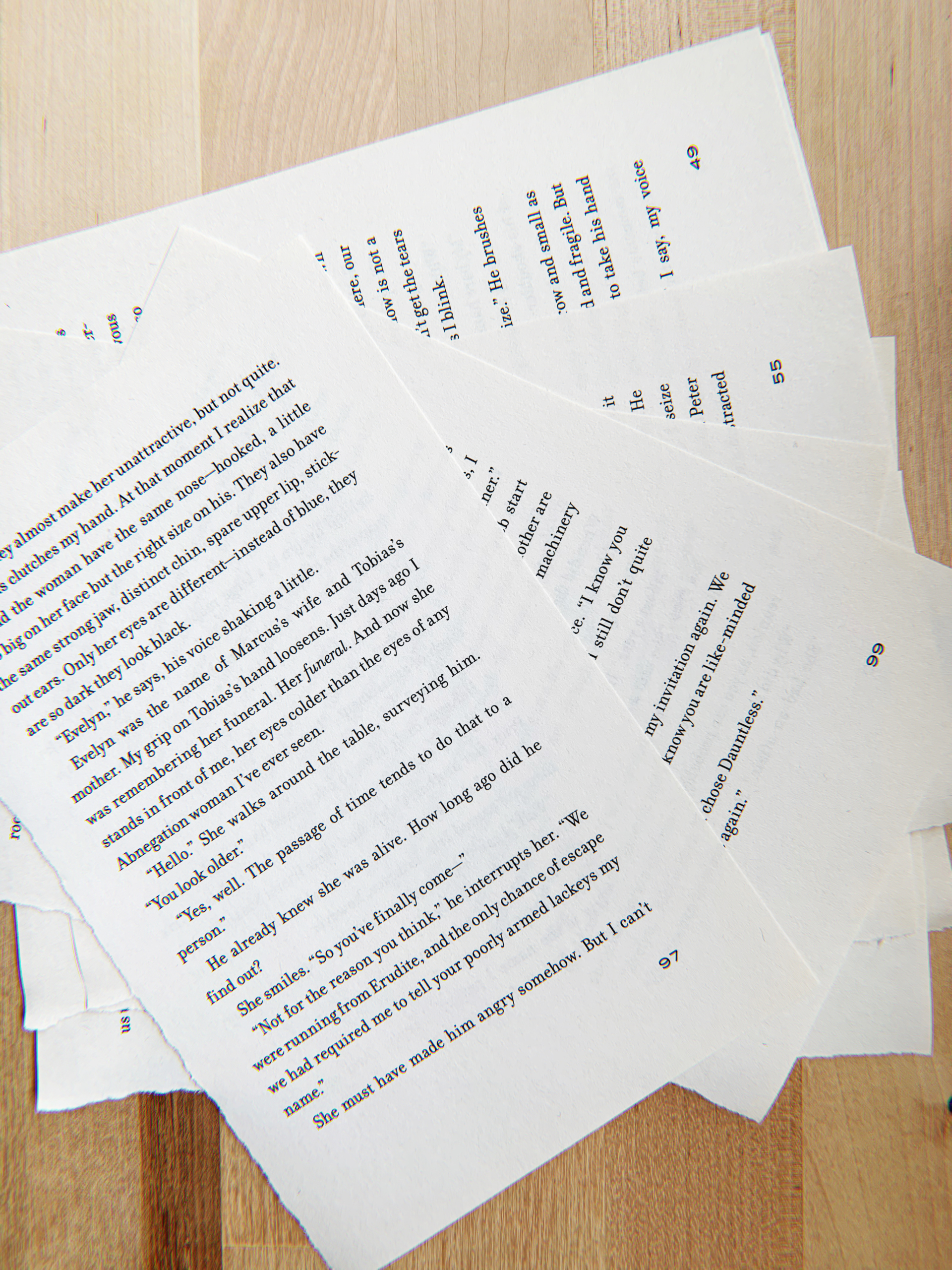
Step Three:
Now it’s time to fold your book pages like an accordion (also called fan-folding). Just create a series of even, parallel pleats, starting at one end of the page and working your way to the other. If you fold the pages carefully, you can stack them and fold two at a time.

Step Four:
Once you’ve finished folding the pages, you can start making them into pinwheels. We’ll actually start by making them into half-pinwheels, which we’ll glue together into full pinwheels when we attach them to the ribbon. To do this, take a page, compress the folds together, and then fold the whole thing in half. Glue the ends together in the middle with your glue gun (see picture), then fan out the rest of the page to make half a pinwheel. Do this for all your pages.



Step Five:
Next, cut a piece of ribbon to the length you want your banner to be, plus a little extra. (Make sure the ribbon is not thicker than the folds of your fan … trust me, it will just look nicer!) Decide how far apart you want to space your pinwheels, and mark where you’re going to place them. I chose to space mine evenly, but feel free to get creative here and vary the distances of your pinwheels. Since I was going for an even look, I used a match box to measure the space between each one.
Pro tip: Make sure you give yourself enough ribbon to work with, so that you have extra on either end to eventually tack or tie up your banner. I started in the center of my long piece of ribbon and worked my way out from there.
Step Six:
Once you know where you want to place your pinwheels, use your glue gun to attach one of the pinwheel halves on top of the ribbon. Next, glue the other half on the bottom of the ribbon to form a round pinwheel. Repeat until you’ve attached all your pinwheels.
When I did this step, I didn’t realize just how much hot glue would come through the ribbon, so be careful here! I found it easiest to just lightly stick the ribbon to the first half of the pinwheel and then use more glue when I attached the second half. That way, I could press the pages against each other with the ribbon glued between them.

Step Seven:
The final step is to reinforce the centers of the pinwheels by putting dots of glue between the first and second folds of each half. Otherwise, the first fold next to the ribbon falls open, making your pinwheels look messy. It’s a little extra step, but makes all the difference in the end, helping your pinwheels look seamlessly attached to the ribbon.

And you’re finished! Hang it up and enjoy!

Let us know what you decide to decorate with your beautiful, eco-friendly book-page banner!

Kelsey Nickerson creates abstract paintings with rich color, texture, and movement, and enjoys a good book craft. She oversees web production and photography for MayaSmart.com.
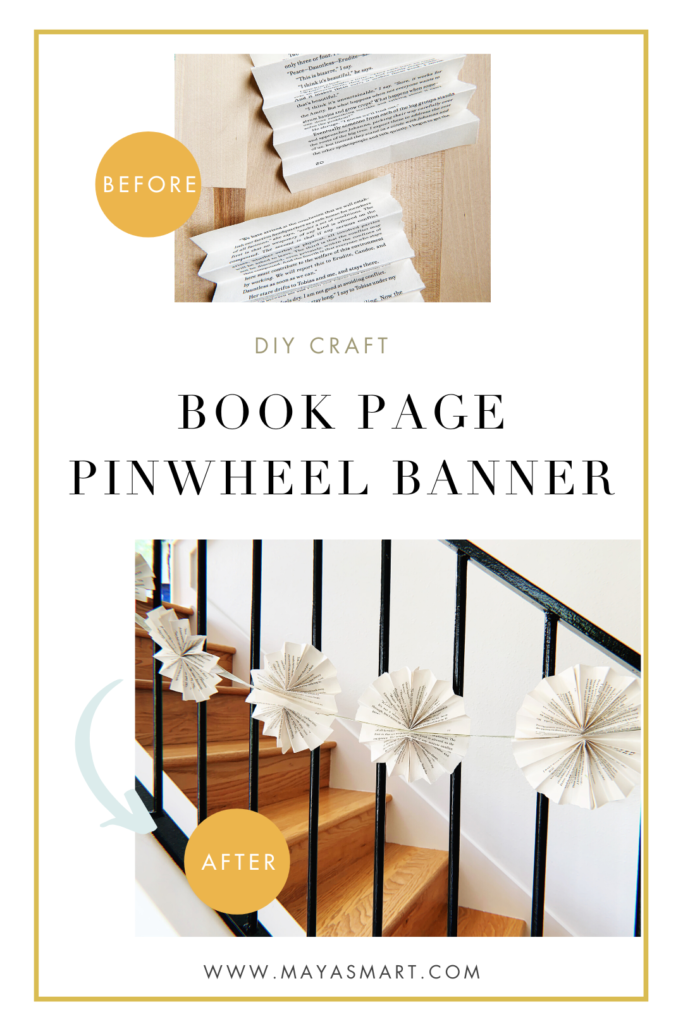
Bookends are among our favorite DIY book crafts. Not only are they a must-have for any book-loving household—they’re also an awesome secret weapon for getting kids to read. Just bookend a selection of tempting titles on a table or anywhere kids will come across them, then let their curiosity do the rest.
We also love bookends for breaking up a book collection into reading levels and subject areas, like fiction genres or nonfiction topics. And when your library overflows, you can extend your shelf space by using them to create rows of books atop a bookcase or counter.
There are so many directions you can take this fun DIY painted brick book craft. Get as detailed as you like, or create an “antiqued” look with a sponge. Bring kids in on the fun and let them decorate their own bookends with handprints or designs from their imaginations. You may even want to create a whole series of bookends to display throughout your home.
To inspire you, here are some photos I found from the Human Behavior blog.


Materials:
- Brick(s) (They don’t have to be perfect! Chips or marks on the bricks give your bookends character.)
- Acrylic paint
- Painters tape
- Paint brushes/rollers
Optional: (But you can always free-hand your design if you’re feeling extra crafty!)
- Letter stencils
- Design stencils
Cost: Hopefully you have some painting materials on hand, but this DIY book craft should cost around $15 if you have to purchase some. Remember, you don’t need to use a brand-new brick. It’s usually easy to find people with leftover bricks to give away. I think old bricks add character to a craft like this!

Step One:
The first thing I did was decide on my design. I spent some time poking around for inspiration. There are many variations to this craft, so it was fun to search for ideas. If you have a favorite book, that’s a great place to start! Knowing where you’ll use your bookend could also help you decide on designs or colors.
Pro Tip: If you want to create a pair of bookends, just remember which side of each brick will be facing out!
I decided to use my bookend for some new cookbooks I have, so I wanted to find a fun design of a colorful cookbook. Here was my inspiration: Julia Child’s Mastering the Art of French Cooking.
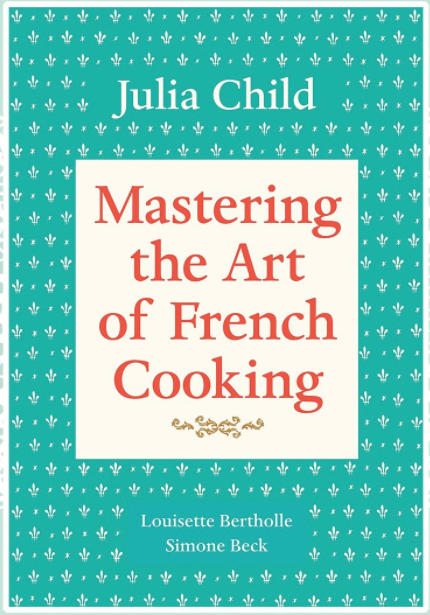
Step Two:
To start, you will put painter’s tape along both short sides of the brick and one of the long sides—these will be the book’s “pages.”

Step Three:
Next, paint the exposed part of the brick. This will be the front and back covers and the spine of your book. You will need to let this paint dry completely before moving on to the next step!


Step Four:
Now you’ll paint the pages of your book. This time, cover the edges that you just painted with painter’s tape, so only the brick you have yet to paint is exposed. Then paint the “pages” white (or gold for an antique gilt-edged look!). Again, wait for the paint to dry before moving on.


Steph Five:
Here’s the fun part! It’s now time to add the details that bring your book to life. In this step, you’ll decorate the spine and front cover of your brick. You can use painter’s tape, stencils, different-sized paint brushes, or even a sponge for the antique look.
You can spend as much or little time as you would like here. You can see from mine that I used the same color scheme and a similar pattern as Julia Child’s cookbook! For the title, I used rubber stamps that I had on hand, but you can also use a stencil or just hand-write your text.


Be sure to let your bookend dry completely, and enjoy! Let us know in the comments how you use your DIY bookend.
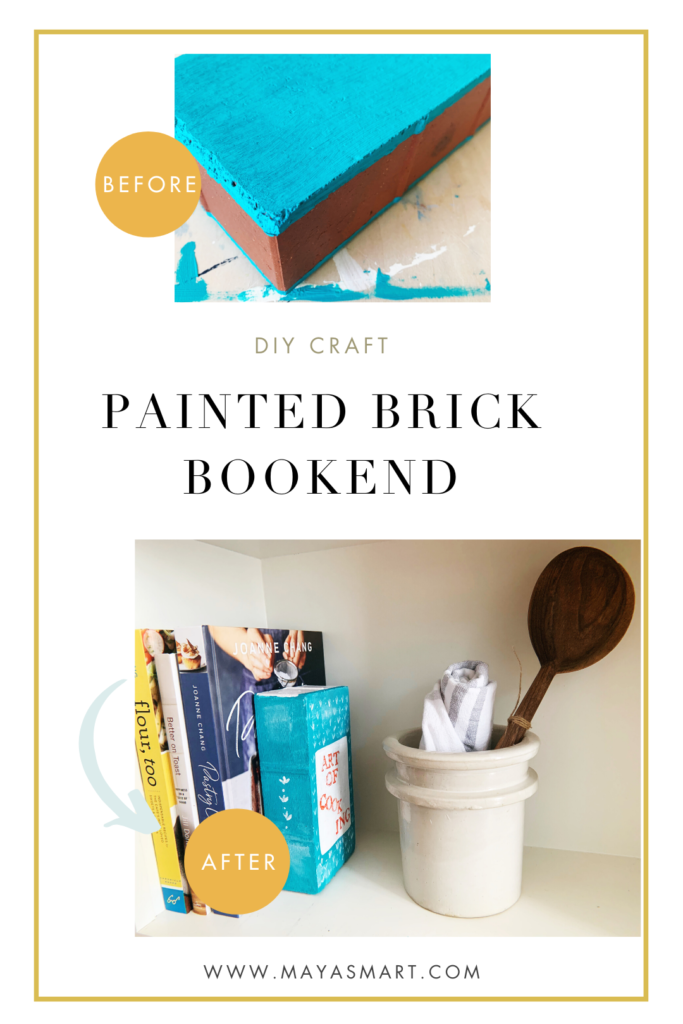
Kelsey Nickerson creates abstract paintings with rich color, texture, and movement, and enjoys a good book craft. She oversees web production and photography for MayaSmart.com.
By nature, children are learners and discoverers. But there are some crucial skills—like letter shapes, names, and sounds—that parents should teach rather than wait for kids to sort out on their own. And the more fun and light-hearted the approach, the better.
Try this neighborhood scavenger hunt activity to engage kids and have family fun outdoors. Getting outside, moving around, and boosting letter engagement is a win-win-win. Benefits include:
- Affordability. You don’t need to purchase a thing for this activity. The items on your hunt list can all be found outside, and you can keep track of items with pen and paper.
- Simplicity. You can read hunt item names aloud for younger children or have more advanced readers scan the list themselves. Easy!
- Health. The neighborhood scavenger hunt is completed outdoors, so it gives you and your child exercise and fresh air.
- Presence. Strolling the neighborhood at a leisurely pace provides a welcome break from technology and a chance to notice surroundings.
- Togetherness. This time spent with your child will strengthen your bond and may lead to future nature walks and educational outings.
Plus, the activity is adaptable enough to try with a wide range of ages. The neighborhood scavenger hunt helps preschoolers and elementary school children increase their letter knowledge. But by incorporating camera phones and social media, your middle schoolers and even high schoolers can get engaged in the hunt as well. They could take pictures of their finds from A to Z and share and compare the results with their friends.
Materials:
- List of hunt items
- Pen
- Notebook or paper (optional)
- Camera (optional)
Steps for Your Neighborhood Letter Scavenger Hunt
- Decide which letters to find. Depending on your child’s age, attention span, and personality, you may opt to use the entire 26 letters of the alphabet, or focus on a subset of letters, such as those in the child’s name. The key is to provide the right level of challenge for your child.
- Set search parameters. After you decide on the letters, figure out how you want your child to look for them. Some examples include:
- Finding items that begin with each letter (A for acorn)
- Finding the letters themselves (S in a stop sign)
- Finding objects that make the shape of a letter (X pattern in a backyard fence)
- Set a time limit. I recommend about 30 minutes for the outdoor scavenger hunt, but you can use more or less time if needed.
- Start hunting. Explain to your child that you’re about to begin an alphabet-inspired adventure and get going!
Alphabet-Inspired Scavenger Hunt Items
Use the suggested items below as inspiration for your list. Be creative and see what alternative scavenger hunt items you and your child can find for each letter. Make adjustments on the fly as you explore your neighborhood on foot.
- Acorn
- Bike
- Cat
- Dog
- Earrings
- Fire hydrant
- Grass
- Hoop
- Insect
- Jump rope
- Kite
- Leaf
- Mailbox
- Neighbor
- Orange
- Pet
- Question
- Rock
- Sign
- Trash can
- Umbrella
- Vehicle
- Water hose
- X shape
- Yard
- Zipper
Four Ways to Customize Your Alphabet Scavenger Hunt
The beauty of neighborhood scavenger hunts is that there are a lot of ways to change this simple activity to keep it engaging for you and your children over time. Here are just a few tips:
- Take turns with your child to find letters. This is especially helpful if your child is having trouble with certain letters and sounds.
- Work with your child to plan a route for the scavenger hunt. If there’s a particular place they love to visit, you can add that stop as part of your plan.
- Create your own list by jotting down items as you find them.
- See how many times you can find a certain letter or letter sound while on the outdoor scavenger hunt. For example, how many items start with the letter S on your hunt?
Three Scavenger Hunt Books for Children
Introduce or extend the activity with some scavenger hunt reading inspiration. Here are a few titles to consider.
The Lunchnapper by Rick DeDonato (Ages: 3-7)
Pipsie and her turtle friend, Alfred, are on the best school trip ever—a nature scavenger hunt! The search deepens when they discover their lunches have gone missing!
Go Find It! An Outdoor Active Scavenger Hunt by Anastasia Kierst (Ages: 5-8)
Outdoor exercise and exploration are essential for young children. Head to your nearest park, playground, or even your own backyard and don’t forget to pack your sense of adventure.
Sunny Day Scavenger Hunt by Meredith Rusu (Ages: 8-12 years)
The WellieWishers are going on a very special scavenger hunt—a colorific one! Each friend chooses a color and whoever finds the most things around the garden in their color wins. This storybook is based on the bestselling American Girl characters.
Try this easy literacy-focused scavenger hunt with your children and let us know how it works for you. How did your kids enjoy finding various alphabet-oriented objects around your neighborhood?

Why not bring a touch of spring into your home, with some reading-themed floral decor? These DIY book-page hydrangeas offer a literary twist on classic paper flowers. Display them around the house or feature them as centerpieces at a festive meal. You can even mix them with real flowers to create a distinctive bouquet.
Tip: These delicate blooms can make unique decorations for a child’s birthday, spotlighting literacy and nature in one pretty package. (Complete the theme with our DIY bookmarks or honey-bear bookends as favors.)
This book craft may be challenging for some younger children, so it’s a good project for one-on-one time with an older kid or for a little me-time. With just three steps, it’s pretty simple for bigger hands once you get the hang of it!
Materials:
- Styrofoam balls or other small balls (I used ping-pong balls, because I had them on hand)
- Scalloped circle paper punch (you can buy various sizes at any craft store; mine was $10 and is 1½” in diameter)
- Pages from obsolete books (or magazines)
- Glue gun and glue sticks
- Unsharpened pencil
Cost: This craft should cost you under $15, depending on what materials you need to purchase.

Step One:
Using your scalloped paper punch, punch out circles from the book pages. These will be the petals of your flowers. You will need quite a few! I must have made about 100 or so. Part-way through, I realized it was most efficient to fold the book pages in half before punching, so I could punch two circles at a time.

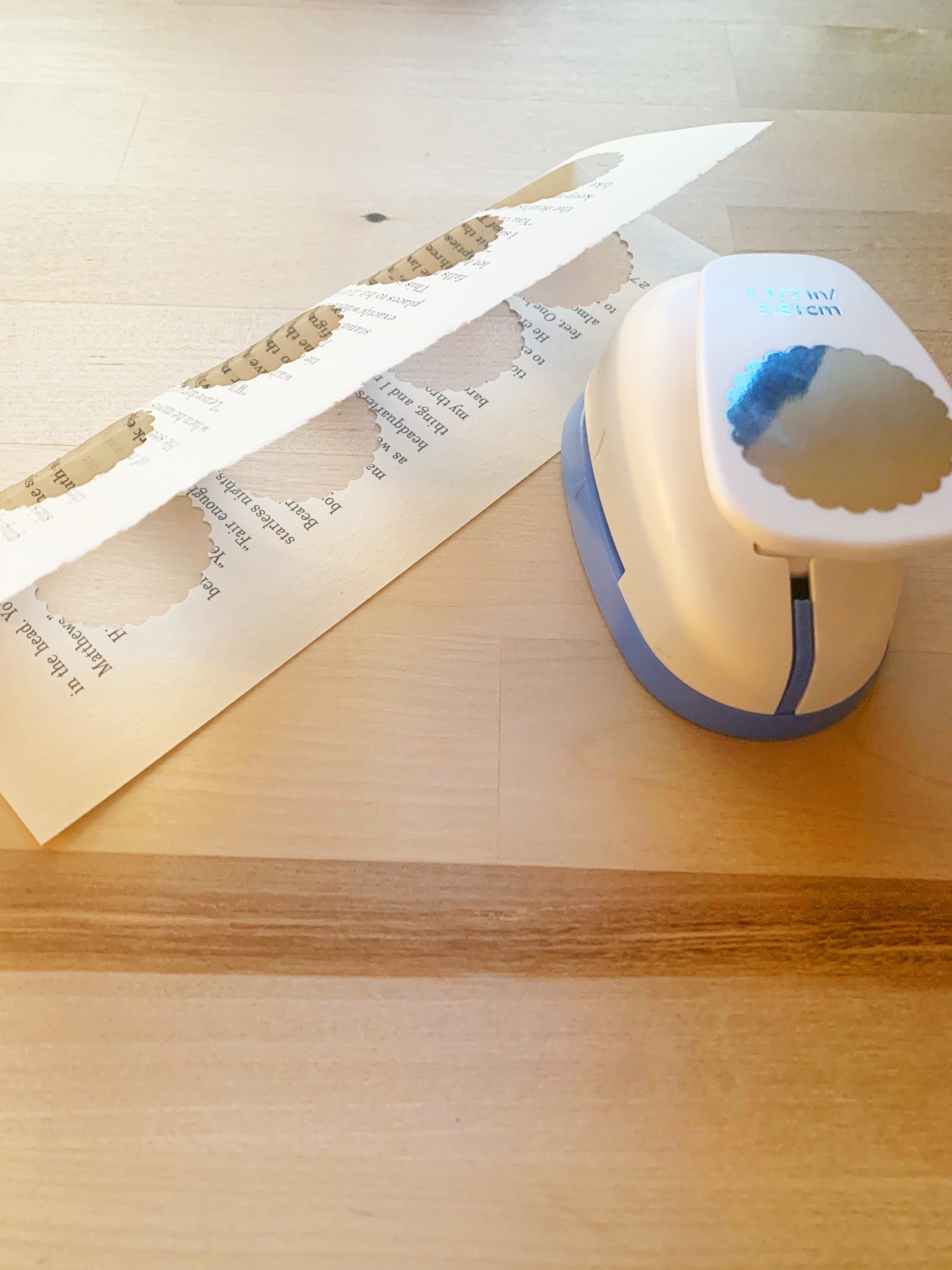
Step Two:
Using the unsharpened pencil, place the center of the paper circle on the end of the pencil, and form the sides of the circle up around it. The paper will look scrunched up, with one small circular flat area. I found it easiest to make a whole bunch of petals before going to the next step of gluing them on.


Step Three:
With the pencil inside one of the petals, take your hot-glue gun and place a small drop of glue on the flat area, then use the pencil to press the petal directly onto the ball. Repeat this process until you have covered the entire ball with your paper petals. You want to make sure to glue the petals as close together as possible, to give your hydrangea the full look you’re going for.


And voila!
Since I used ping-pong balls, my flowers are all the same size. Next time I do this craft, I think it will be fun to use different-sized balls to create varying sizes. You could also try mixing up the petal sizes, by using different-sized hole punches.

You can arrange your paper hydrangeas in a bowl or vase, place them along a bookshelf or mantelpiece, or even scatter them over a tablecloth for a charming effect. You might try pairing them with a bold color or bright flower petals, to offset the subtle tones of your paper flowers.
Let us know in the comment section how you arrange your brainy blossoms.

Looking for a way to beautify a room and highlight reading at the same time? This DIY book craft, inspired by A Fresh Squeezed Life, creates a lovely painted book stack. It can bookend your favorite titles on a shelf or hold its own as a table accent. Either way, it makes a unique addition to a child’s room, living room, or office.
Affordable and fun, this is the perfect way to upcycle obsolete or outdated books (old textbooks, anyone?) and display an inspirational phrase in your home. Go ahead and get creative in choosing what to stamp on your upcycled book stack!
MATERIALS:
- Obsolete books
- Alphabet stamps
- Paint (I used white acrylic paint, but you could also use chalk paint)
- Foam brush
- Miscellaneous ribbon or twine and greenery for decoration (or anything else you can think of!)
- Glue gun and glue sticks
- Sandpaper (for correcting any mistakes)
Cost: You may have most of these materials on hand already! But this project should not cost more than $15-20 even if you have to purchase some materials.

Ideas for Quotes:
What phrase will you showcase on your upcycled book stack? Feel free to borrow the one I used, or pick your own. Here are a few ideas to get you started:
- Choose a quote about reading. Goodreads has a list of reading-related quotes.
- Use a quote you love from a book. Or choose one from a child’s favorite book to encourage their reading.
- Write your own or invite your child to take the lead.
Share what you use in the comments!
Step One:
Set up your work surface by laying down scrap paper. Make sure you have enough room to lay out all the books you’re using. Then paint the spines of your books with a few thick coats of paint, letting each coat dry before you add the next one. Because many hardcovers have titles embossed or imprinted on the spines, you’ll need to put on enough paint to create a smooth surface. It took me about four coats to get even coverage.

Step Two:
Now you’re going to move on to the sides of the books. Again, apply nice, even layers of paint, letting them dry in between. You won’t need to apply the paint as thick in this step. I did 2 coats here, just enough to have solid coverage over the book cover.

Step Three:
Lastly, paint the inside edges of the book. Just a single coat is fine here!

Step Four:
Let the books dry completely. Don’t rush this step! I recommend waiting at least a few hours.
Step Five:
Now the fun part! Decide what quote or message you want to have on your book stack. You will want to double-check that the words fit on the spine. To do this, simply line up your stamps next to the book as you’re planning to stamp them.

Step Six:
Stamp the spine of your book just as you mapped it out in the previous step. Don’t make yourself crazy trying to stamp each letter perfectly. The imperfections add a little character to the project and will make your book stack extra cute in the end! If you do make a mistake or have excess ink that really bothers you, don’t worry: You can use sandpaper to remove the ink. I thought this step was going to be tricky, but it was actually my favorite part of the craft, so just have fun with it.

Step Seven:
The final step is assembling your book stack and adding the finishing touches. Pick materials to go along with your theme, like different ribbons, twine, and greenery or other decorations! Now, glue the books one on top of the other with your glue gun. Then tie ribbon or twine around the stack, securing with glue as needed, and glue on any other decorations you choose.

And remember: this project is about expressing book love and bringing something fresh, beautiful, and meaningful into your home. Don’t stress about perfect painting, stamping, or styling. Whatever you end up with is uniquely yours and perfectly charming. Work with what you’ve got, get creative, and have fun!
What quote or phrase would you use on your book stack? Let us know in the comments!
Kelsey Nickerson creates abstract paintings with rich color, texture, and movement, and enjoys a good book craft. She oversees web production and photography for MayaSmart.com

Every book deserves a bookmark. And creating your own signature design is a fun and easy DIY book craft that doesn’t require tons of materials or cleanup! Just like children often eat more vegetables when they help prepare a meal, kids can feel more invested in books when they personalize them with special bookmarks all their own.
Try this quick craft project, inspired by Somewhat Simple, to engage your kids with the titles on their bookshelves. A custom bookmark with a shiny ribbon might be just the thing to encourage them to crack open that new book. Of course, a great story’s your best bet to keep the pages turning once they do.
MATERIALS:
- Scrapbook paper or other patterned paper (or paint or color your own)
- Old book or magazine pages
- Scissors
- Glue stick
- Fun ribbon
- Standard round hole punch
- Optional: Craft punches (I used a star and heart shape, but there are endless choices!)

A Word on Book Page Crafts
You need to cut up pages of print for this DIY craft. As a book lover, I understand that cutting up a book can feel wrong. But I celebrate the idea of upcycling truly outdated and obsolete books to give them a second life and fresh purpose. Outdated law, science, or medical texts and irreparably damaged books of all kinds are great candidates for upcycling—guilt free.
Now, let’s begin!
STEPS
1. Pick fun, bright paper for your designs! Let kids choose their own paper to get them engaged in the activity. You can also use cardstock craft paper for sturdier bookmarks. If you don’t have any scrapbook paper or patterned cardstock lying around, take this craft to the next level by coloring or painting a pattern on plain paper.

2. Cut your scrapbook paper and book or magazine pages to the size you want for your bookmark. I traced a small box, but you could use a ruler instead, or trace a bookmark you already have. Cut two pieces of your scrapbook paper and one piece of the book/magazine for each bookmark.


3. Use decorative punches if you have them, or a regular hole punch, to punch out a design on one of the pieces of your patterned scrapbook paper. Get creative! The best surprise is what your pattern looks like with your book page behind it.

4. Put glue all over the backside of your punched scrapbook paper, then place it on top of your book or magazine page. Press firmly to secure. Put a generous amount of glue on your other piece of scrapbook paper and press to the backside of your bookmark.

5. Add a small hole with your regular hole punch at the top of your bookmark. Loop some ribbon through, tie it off, and you’re done!

Now you and your children have beautiful bookmarks to hold your spot as you read.
This DIY bookmark craft is as versatile as it is easy, and there are endless ways to use the bookmarks you create. Think inexpensive favors for a birthday party, shower, or wedding—or gift tags during the holidays. So many possibilities!
Will you try this DIY book craft with your kids? Let us know what you think!
Kelsey Nickerson creates abstract paintings with rich color, texture, and movement, and enjoys a good book craft. She oversees web production and photography for MayaSmart.com.
